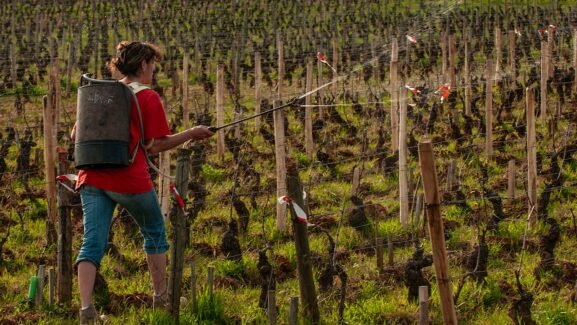The Rise of Massal Selection
Of Gloria Ferrer’s 330-acres of estate vineyards in the Los Carneros AVA, 35 are massal vines.
“Grapes from these blocks are continually used in our highest quality cuvees, and the wines show an unrivaled complexity,” winemaker Brad Kurtz says.
Hand-chosen for their unique strengths and attributes, those massal vines include Pinot Noir cuttings, dating back to 1984, that showed promise for sparkling wine due to their tendency to produce low-color, high-acid red wines.
Massal selection (a.k.a. sélection massale in French) is the viticultural practice of replanting vineyards with propagated buds from exceptional existing vines on the surrounding (or nearby) property.
The method not only helps winemakers pick the best plant specimens for their terroir and intended purpose, but these oftentimes old vines—many of which originate from European cuttings—also help to preserve centuries of viticultural history and are now thought to be a potential hedge against a rapidly changing climate.
The Ancestral Roots of Massal Selection
Known as the “old way” of propagating vineyards, the practice, says Jean-Marc Vincent, founder of Domaine Jean-Marc Vincent in Burgundy, began with “generations of peasants with a collective brain as powerful as any modern technology.”
Long before phylloxera (and even after), quality-minded growers would select their best vines for propagation.
Vincent explains that peasant farmers would watch their plants for years, noticing advantageous mutations in terms of taste, hardiness and other attributes. Maybe one particular plant drops smaller clusters with intense flavor concentration. Maybe another ripens earlier than its neighbors, making it better-suited to a cool climate.
But these farmers knew it would be unlikely to end up with the same, say, Chardonnay, by planting its grape seeds. This is because every seed carries genetic material from its two parents, rendering each offspring genetically unique. Therefore, the chances of replicating a plant from its seeds are extremely low—maybe one in 500,000
So, to multiply and maintain the desirable characteristics of that specific vine, farmers took wood cuttings, rooted them and then grafted another massal-selected cutting on top of that rootstock to continue the genetic line. These special vines would be—and still often are today—propagated together into a grouping. This practice leads to unique vine populations within established varietals that are wholly unique to a particular vineyard, village or region.
The distinctive and favorable mutations that arise from these selections become more readily apparent over time. David Gates, senior vice president of vineyard operations at Ridge Vineyards in Northern California and a Historic Vineyard Society board member, says “if you’re observant, you choose those vines, and can make something a little bit different.”
In the 1990s, Gates hand-picked Zinfandel vines from four 19th-century Northern California growing sites that were originally brought over from European vineyards (making them massal selections by default) to create Ridge’s massal-selected vineyards.
He’s found these hearty vines have been particularly adept in combating viruses like red blotch, which destroys chlorophyll-producing cells and halts photosynthesis.
As has been done for centuries, Ridge’s massal selected vines were propagated from a wide group of desirable parent plants in the vineyard. This system, which fosters genetic diversity, differs from modern clonal selection, a far more common practice these days where new vines are propagated from a single parent vine.
The Modern-Day Evolution of Massal Selection
Each generation develops its own techniques to guard against potential threats to a vineyard and coax the best qualities out of them. Today, some winemakers are bridging ancient and modern techniques by combining massal selection with genetic clones.
Back in the mid-20th century, there was a global push to eliminate viruses from vineyards with the goal of ensuring better yields, longevity of vines and reliable accumulation of sugar in the grapes.
As a result, many research institutions, such as the French Wine and Vine Institute (FIV) and U.C. Davis Foundation Plant Services (FPS), developed clones, propagating the healthiest plants to resist disease. These organizations now have vast catalogs of clones that have been sourced from all over the world.
In the U.S., FPS is the leader in the United States with a collection of 574 grapevine varieties for wine, food, juice and more.
Because there are now so many certified clones available, it’s possible to have a genetically diverse massal selection that’s entirely composed of them. “We have our favorite clones,” says Gates. “We plant them in various percentages and then go out in the field and bud them to end up with a massal selected vineyard with all clean, virus-free material.”
Eliminating debilitating viruses in clean-stock massal vineyards gives them a better chance of survival when faced with new threats, like climate change. But growers need to be careful, says Gates, about “selecting as many clones as possible that fit the quality parameters for your new ‘massal’ vineyard” to make up for the potential lack in genetic diversity.
Part of the reason why winemakers are turning to massal selection, in the first place, is because their plantings are more genetically diverse than clonal plantings. This gives producers the upper hand.
For example, while a lower-vigor vineyard planted with all the same clones may struggle in drought years, a massal planting will potentially have high- and low- vigor vines within the same vineyard, which can produce more consistent quality and increased complexity year-over-year, Kurtz says.
Additionally, as viticulturists select budwood to propagate for new massal vineyards, the vines from which they are pulling cuttings have been forced to perform under recent climate conditions. This enables vineyards to better withstand the fluctuations in weather.
Massal Vines in a Changing Climate
“As we face challenges due to a changing climate, these plantings provide more resilience to unpredictable conditions,” says Kurtz
With a diversity of hardy, resilient vines planted in one plot, grape growers have some insurance against climate extremes.
For example, if a vineyard is planted with just one clone that responds poorly to climatic conditions during bloom, leading to an unusable crop, low yields can be devastating. But if that clone occupies only 10% of the vine population, the poor performance matters less, as other varieties in the vineyard will still thrive. “Anytime you increase genetic diversity, it helps,” says Gates.
Additionally, Gates adds, such diversity avoids a monoculture in the vineyard, which can lead to impoverished soil and diminished biodiversity, and supports greater complexity in forthcoming wines from that vineyard.
Preserving Agricultural History With More Flavor
Enrique Tirado, winemaker and CEO of Viña Don Melchor in Chile’s Puente Alto appellation, appreciates the intricate aromas and resilience of massal-selected vineyards. The 100 to 200 different Cabernet Sauvignon vines, which hail from varied soils along the Maipo River, that are combined in his annual blend “brings something distinct and essential” to the wine, he says.
Some parcels contribute red fruit character, floral or spicy notes, or delicate or concentrated tannins, freshness or acidity.
Since starting in the late 1970s, Tirado has continued on with the tradition of massal selection, planting another 900 specimens in 2018, in the shape of a radial sundial, with the goal of achieving the highest possible quality.
He’s learned a lot, but most significantly this latest experiment has helped him to confirm temperature fluctuations are more extreme than 15 to 20 years ago and rainfall is significantly lower. “We know that we have to be smart, and manage it in a good way,” he says.
There is, however, far more to those 19th-century pre-phylloxera, own-rooted, massal vines than their ability to withstand climate change while creating bold, flavorful wines. They are a living slice of agricultural history, first planted with cuttings brought over from Bordeaux in 1883.
While all the other attributes of massal selection are significant, for the winemakers who continue on with the tradition, this link to the past may be one of the most important attributes of the practice.
Gates, for example, points to how massal selection has helped to preserve valuable DNA from Zinfandel across the globe.
It is a very old variety. An early iteration called Tribidrag has grown on Croatia’s Dalmatian Coast since the 1300s, and has three different clonal mutations. To uphold the varietal’s history, Ridge sources three different clones derived from Tribidrag, as well as Primitivo, another Zinfandel clone that grows in Puglia.
“Nurseries will have 100 choices for Cabernet and Chardonnay, and maybe one or two for Zinfandel,” says Gates. “So, the only thing keeping the bloodline going from old vines and vineyards is massal selection.”
Since importing these cuttings to California, Gates has been able to dig deep into understanding and highlighting their subtle differences in flavor and aroma. This work has been a point of pride for him. “The origin of Zinfandel had been a viticultural mystery for the better part of a century and a half, and it was personally thrilling to be able to watch it unfold,” he says.
By turning an eye to massal selection, Gates and others have been able to use an ancient agricultural practice to not just grow better, more flavorful grapes but to safeguard viticultural history and preserve culture.
More Grapevine Coverage
From the Shop
Find Your Wine a Home
Our selection of wine glasses is the best way to enjoy a bottle’s subtle aromas and flavors.
Published: August 16, 2024
Like what you’re reading? Learn more about:

